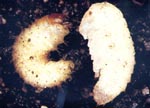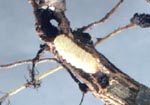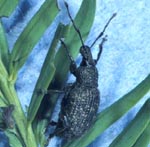|
Description
The adult weevil is approximately 3/8 inch in length and brownish
black. Small patches of golden scales are scattered on the
wing covers. The adults are nocturnal feeders. The head of
the adult projects into a long, broad snout. The larva are
white, legless, grubs approximately 3/8 inch long when mature,
and have a dark head.
|
Click
on image for larger version

Figure 1. Black Vine Weevil Pupa (left) and
Larva (right)
|
Life
History
Only one generation of the weevil occurs outdoors, annually. The
adults appear during June and early July. They feed on foliage at
night by cutting characteristic U-shaped notches in the foliage
of the host plant. During the daylight hours the adults hide in
the debris and loose soil at the base of the plant. Eggs are laid
during July and August in the soil under the plants on which the
adults feed. As the eggs hatch the larvae burrow into the soil and
feed on the roots. They overwinter in the soil as full-grown larvae
and develop into pupae in late May or early June. Eggs are deposited
without fertilization and only females are produced. No males have
been observed with this species. The beetles cannot fly, so infestations
spread slowly from one area to another. However, rapid spread may
occur in a localized area.
|
Click
on image for larger version

Figure 2. Black Vine Weevil Larva and Damaged Root
|
Damage
The black vine weevil feeds on over 100 different kinds of
plants including flowers, weeds, trees, and woody ornamentals.
yew (Taxus spp.) appear to suffer the greatest damage from
larval root feeding. Taxus capitata seems to be particularly
susceptible. Heavily infested plants turn yellow and eventually
die if the injury continues. The economic importance of this
insect has increased because of the increased popularity of
various species of Taxus for ornamental purposes and the increase
in size and number of Taxus plantings in nurseries. In some
cases, hundreds of plants have. been killed suddenly just
after reaching a marketable stage.
|
|
Nonchemical Control
Isolation of infested plant material will greatly reduce the
spread of blackvine weevil larvae. Predaceous nematodes are
available for control of the larvae in containers and landscape
beds.
Chemical
Control
Insecticidal sprays may be applied to the foliage in mid-May
when adult are present on the foliage allowing the spray to
run off onto the soil under the shrubs. Treatments should
be repeated twice at 2 week intervals.
|
Click on image for larger
version

Figure 3. Black Vine Weevil Adult and Damage on Yew
|
|

